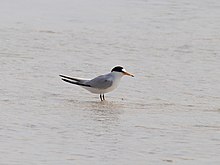| Saunders's tern | |
|---|---|

| |
| Saunders's tern, Saudi Arabia | |
| Conservation status | |
 Least Concern (IUCN 3.1) | |
| Scientific classification | |
| Domain: | Eukaryota |
| Kingdom: | Animalia |
| Phylum: | Chordata |
| Class: | Aves |
| Order: | Charadriiformes |
| Family: | Laridae |
| Genus: | Sternula |
| Species: | S. saundersi |
| Binomial name | |
| Sternula saundersi (Hume, 1877) | |
| Synonyms | |
|
Sterna saundersi | |
Saunders's tern (Sternula saundersi), sometimes known as the black-shafted tern, is a species of bird in the family Laridae. It is sparsely resident along the shores of the north-western Indian Ocean (namely southern Somalia, Arabian Peninsula, Socotra, Pakistan, Andaman and Nicobar Islands and northern Sri Lanka).
It is a close relative of the little tern, least tern, yellow-billed tern, and Peruvian tern. In non-breeding plumages, the Saunder's tern and the little tern may be almost indistinguishable. The two have been considered by some to be conspecific.
Description
Saunders's tern shares many of the features of its close relative, the little tern, including a white body, a black-tipped yellow bill, and a black cap with a white forehead patch. In its breeding plumage, it distinguishes itself with a straight-bordered forehead patch, possessing more black outer primaries, and duskier colored legs and feet in comparison to the bright yellow legs of the little tern. In non-breeding plumage, the two are very similar.
Saunders's tern is 20–28 cm (8-11 in) long, weighs 40-45 grams, and possesses a wingspan of 50-55 cm(20-21 in). It has an average wing length of 16.6 cm(6.5 in), an average bill length of 2.8 cm(1.1 in), and a tail fork depth of about 2.8 cm(1.1 in) on average.
Taxonomy
Saunders's tern was first described in 1877 by British botanist and ornithologist Allan Octavian Hume during his stay in British India as part of the Imperial Civil Service. It was originally given the name black-shafted ternlet (Sterna saundersi) by Hume, which was later changed to its present common name.
It is considered by some to be a subspecies of Sternula albifrons, potentially of a larger species group, or otherwise conspecific.
Behavior
Feeding
The majority of the Saunders's tern's diet consists of various marine animals, including small fish, crustaceans, and mollusks. It will also eat several varieties of insects. An individual will hover above the water for a sizable amount of time, before making a plunge dive to catch fish.
References
- BirdLife International (2019). "Sternula saundersi". IUCN Red List of Threatened Species. 2019: e.T22694666A155479775. doi:10.2305/IUCN.UK.2018-2.RLTS.T22694666A155479775.en. Retrieved 15 November 2021.{{cite iucn}}: |volume= / |doi= mismatch, |date= / |doi= mismatch (help)
- "Saunders's Tern (Black-shafted Tern) – Sternula saundersi". Finnish Biodiversity Information Facility.
- ^ Gochfeld, Michael; Burger, Joanna; Kirwan, Guy M.; Garcia, Ernest (March 4, 2020). "Saunder's Tern". Birds of the World.
- Chandler, Richard; Wilds, Claudia (February 1994). "Little, Least and Saunders's Little Terns". British Birds. 87 (2): 60–66.
- Moulton, Edward (2003). "The Contributions of Allan O. Hume to the Scientific Advancement of Indian Ornithology". In J. C. Daniel; G. W. Ugra (eds.). Petronia: Fifty Years of Post-Independence Ornithology in India. New Delhi, India: BNHS, Bombay & Oxford University Press. pp. 295–317.
- Almalki, Mohammed (March 2021). "Breeding biology of Saunders's tern (Sterna saundersi) in the Farasan Islands, Kingdom of Saudi Arabia". Saudi Journal of Biological Sciences. 28 (3): 1931–1937. doi:10.1016/j.sjbs.2020.12.044. PMC 7938151. PMID 33732079. S2CID 232240844.
| Taxon identifiers | |
|---|---|
| Sternula saundersi |
|
| Sterna saundersi | |
This Charadriiformes-related article is a stub. You can help Misplaced Pages by expanding it. |